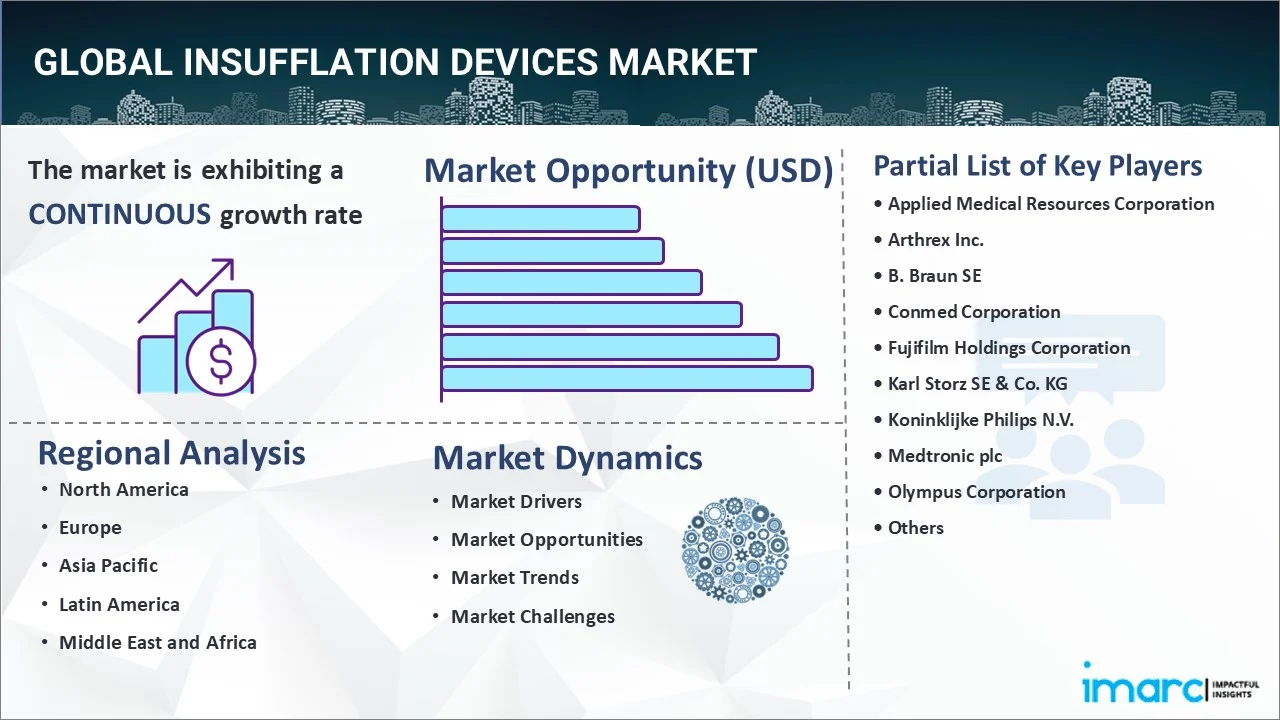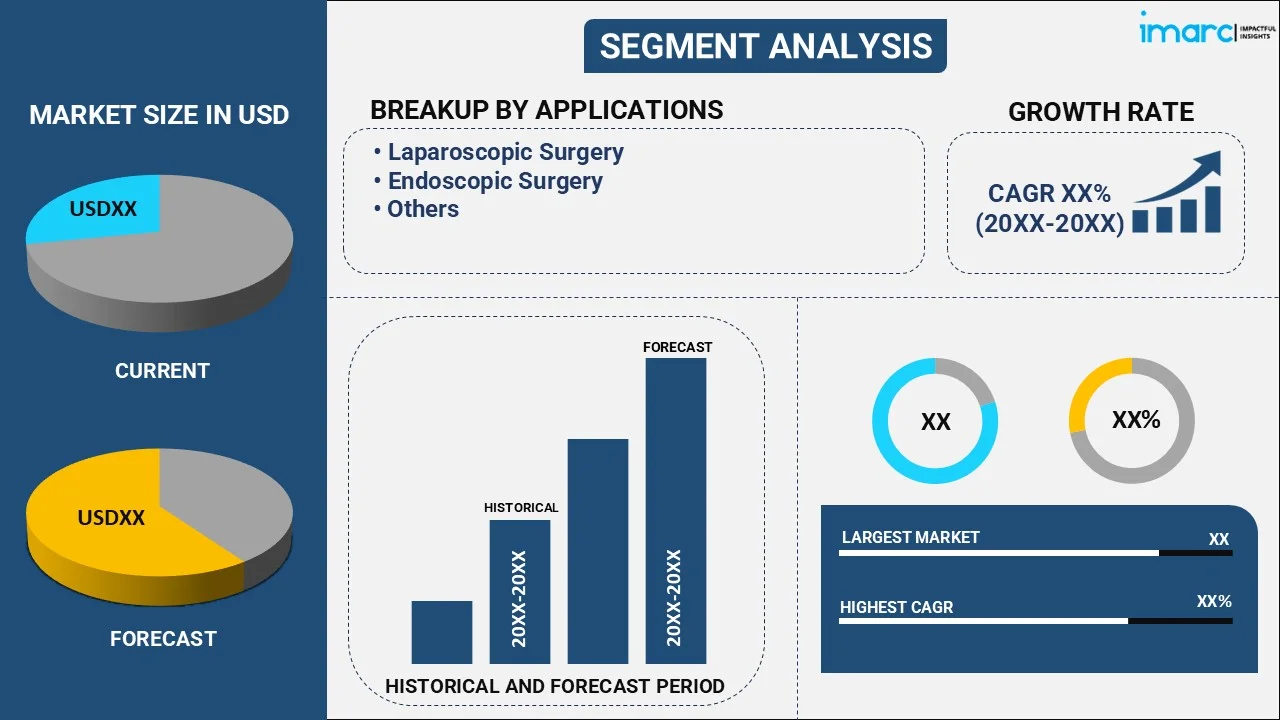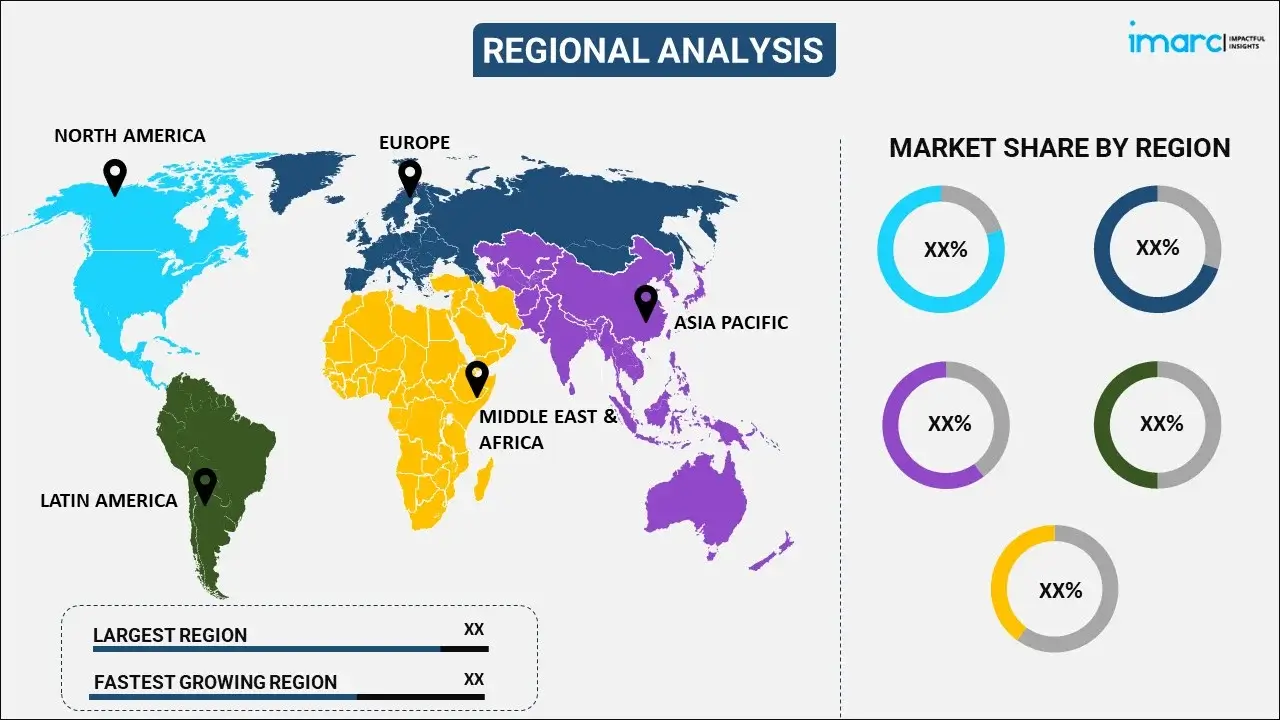
Insufflation Devices Market Report by Application (Laparoscopic Surgery, Endoscopic Surgery, and Others), End Use (Hospitals, Dental Clinics, Ambulatory Surgical Centers), and Region 2025-2033
Market Overview:
The global insufflation devices market size reached USD 2.9 Billion in 2024. Looking forward, IMARC Group expects the market to reach USD 5.0 Billion by 2033, exhibiting a growth rate (CAGR) of 6.1% during 2025-2033. The rising prevalence of chronic disorders among the masses, the increasing preference of patients and healthcare workers towards minimally invasive surgeries, and continual technological advancements in insufflation device technology are some of the major factors propelling the market.
|
Report Attribute
|
Key Statistics
|
|---|---|
|
Base Year
|
2024 |
|
Forecast Years
|
2025-2033
|
|
Historical Years
|
2019-2024
|
| Market Size in 2024 | USD 2.9 Billion |
| Market Forecast in 2033 | USD 5.0 Billion |
| Market Growth Rate (2025-2033) | 6.1% |
Insufflation devices are medical devices used to introduce a gas, typically carbon dioxide (CO2), into body cavities during various minimally invasive surgical procedures. These devices work by delivering a controlled flow of gas, typically carbon dioxide, into the patient's body cavity. This controlled inflation is used to create a working space, that provides surgeons with better visibility and accessibility by distending the body cavities. In addition to this, it separates the organs to minimize damage and reduces the risk of infection by limiting direct contact with open air. Insufflation devices are primarily used to create and maintain a stable, expanded space within the body during laparoscopic surgeries and endoscopies.

The global market is primarily driven by the growing geriatric population that is more susceptible to surgeries that necessitate insufflation devices. Additionally, numerous improvements in healthcare infrastructure, particularly in developing countries, is leading to an increase in the number of surgeries performed and the demand for these devices. In line with this, considerable rise in medical tourism for cost-effective, advanced treatments is also bolstering the market demand. Moreover, the increase in training and education for healthcare providers regarding the benefits and usage of insufflation devices is a significant factor for higher product adoption. Furthermore, the rising number of regulatory approvals for innovative devices and extensive research and development (R&D) activities are creating a positive market outlook. Apart from this, favorable reimbursement scenarios for surgical procedures by the government bodies in several countries are impacting the market positively.
Insufflation Devices Market Trends/Drivers:
Increasing preference towards minimally invasive surgeries
Minimally invasive surgeries are rapidly gaining popularity due to their numerous advantages over traditional open surgeries. With smaller incisions, patients experience reduced scarring, less post-operative pain, and a lower risk of infection. Furthermore, these procedures often result in shorter hospital stays, leading to cost savings for both patients and healthcare systems. The faster recovery times associated with minimally invasive surgeries allow individuals to return to their daily activities more quickly, improving their quality of life. Insufflation devices play a crucial role in creating the necessary pneumoperitoneum or gas-filled space required for these procedures. By maintaining the appropriate pressure and space within the body cavity, insufflation devices enable surgeons to have better visibility and maneuverability during the surgery, contributing to their increasing demand and driving the growth of market on a global level.
Continual technological advancements in insufflation device technology
Continual advancements in insufflation device technology have significantly improved their safety, efficiency, and user-friendliness. Advanced insufflators now offer precise gas flow control, ensuring optimal pressure levels are maintained during the procedure. Integrated smoke evacuation systems effectively remove surgical smoke, enhancing visibility for surgeons and reducing potential health risks. Additionally, insufflation devices now incorporate better patient monitoring capabilities, enabling real-time assessment of vital signs and patient parameters during the surgery. Surgeons are increasingly adopting these advanced devices to enhance surgical outcomes, reduce complications, and improve patient safety. The continuous drive for improved surgical techniques and outcomes, along with the growing preference for minimally invasive procedures, has fueled the demand for technologically advanced insufflation devices in the global market.
Growing prevalence of chronic diseases
The augmenting incidences of chronic diseases, such as obesity, gastrointestinal disorders, and gynecological conditions, has led to a significant rise in surgical interventions. Minimally invasive procedures, enabled by insufflation devices, have become the preferred choice for managing these conditions effectively. Laparoscopy, robotic surgery, and hysteroscopy are commonly performed using insufflation devices in patients with chronic diseases. As the prevalence of these conditions continues to grow, the demand for such surgical interventions is increasing accordingly. Insufflation devices are essential in creating the pneumoperitoneum required for these procedures, facilitating better visualization and access to the targeted area. They enable surgeons to perform these procedures with precision, minimal invasiveness, and improved patient outcomes, driving their adoption in healthcare facilities worldwide. The growing patient pool requiring surgical interventions for chronic diseases is a key driver behind the expansion of the insufflation devices market.
Insufflation Devices Industry Segmentation:
IMARC Group provides an analysis of the key trends in each segment of the global insufflation devices market report, along with forecasts at the global, regional, and country levels from 2025-2033. Our report has categorized the market based on application and end use.
Breakup by Application:

- Laparoscopic Surgery
- Endoscopic Surgery
- Others
Laparoscopic Surgery dominate the market
The report has provided a detailed breakup and analysis of the market based on the application. This includes laparoscopic surgery, endoscopic surgery and others. According to the report, laparoscopic surgery represented the largest segment.
Technological advancements in laparoscopic surgical techniques and equipment have improved surgical outcomes, reducing invasiveness and recovery times, driving the demand for insufflation devices The increasing prevalence of chronic diseases like obesity, gastrointestinal disorders, and gynecological conditions has fueled the demand for laparoscopic surgeries, requiring insufflation devices to enhance visibility and create a clear operating field. The minimally invasive approach of laparoscopic surgery, with its benefits of smaller incisions, reduced pain, and faster recovery, has led to higher demand for insufflation devices as both patients and healthcare providers prefer this approach.
On the other hand, endoscopic surgery segment is driven by the growing incidence of gastrointestinal disorders, such as gastrointestinal bleeding, colorectal cancer, and inflammatory bowel diseases, which require endoscopic procedures facilitated by insufflation devices for diagnosis and treatment. Advancements in endoscopic technology, including high-definition imaging and flexible endoscopes, have expanded the range of procedures that can be performed endoscopically, increasing the demand for insufflation devices. The preference for minimally invasive procedures, which offer reduced pain and faster recovery, has further fueled the demand for endoscopic surgeries and the need for insufflation devices.
Breakup by End Use:
- Hospitals
- Dental Clinics
- Ambulatory Surgical Centers
Hospitals hold the largest share in the market
A detailed breakup and analysis of the market based on the end use has also been provided in the report. This includes hospitals, dental clinics, and ambulatory surgical centers. According to the report, hospitals accounted for the largest market share.
The factors driving the hospitals segment of the global insufflation devices market include the increasing prevalence of chronic diseases and the subsequent rise in surgical procedures, leading to the higher demand for insufflation devices in hospitals. Additionally, technological advancements in insufflation devices, such as the development of minimally invasive surgical techniques, have further fueled the adoption of these devices in hospital settings. Moreover, the growing healthcare infrastructure in emerging economies and the focus on improving patient outcomes have contributed to the expansion of the hospitals segment in the market.
On the other hand, the clinics segment is driven by the rising trend of outpatient surgeries performed in clinics rather than hospitals has created a significant demand for insufflation devices in these settings. Also, the increasing emphasis on cost-effective healthcare solutions and the ability of clinics to provide specialized care have propelled the adoption of insufflation devices in clinic settings. Additionally, continual technological advancements in insufflation devices, such as the development of portable and user-friendly devices, have made them more suitable for use in clinics, further driving the market growth.
Moreover, the growth of the ambulatory surgical centers (ASCs) segment can be attributed to the shift towards ambulatory care for surgical procedures due to advantages including reduced hospital stays, lower costs, and faster recovery times. In addition to this, the advancements in insufflation technology, such as the integration of advanced imaging systems and improved gas flow control, have made them more suitable for use in ASCs. Lastly, favorable reimbursement policies and government initiatives promoting the establishment of ASCs have also contributed to the growth of this segment in the insufflation devices market.
Breakup by Region:

- North America
- United States
- Canada
- Europe
- Germany
- France
- United Kingdom
- Italy
- Spain
- Others
- Asia Pacific
- China
- Japan
- India
- South Korea
- Australia
- Indonesia
- Others
- Latin America
- Brazil
- Mexico
- Others
- Middle East and Africa
North America exhibits a clear dominance, accounting for the largest insufflation devices market share
The report has also provided a comprehensive analysis of all the major regional markets, which include North America (the United States and Canada); Europe (Germany, France, the United Kingdom, Italy, Spain, and others); Asia Pacific (China, Japan, India, South Korea, Australia, Indonesia, and others); Latin America (Brazil, Mexico, and others); and the Middle East and Africa.
North America held the biggest market share since the region has a well-developed medical infrastructure and comprises of developed nations such as the United States and Canada. This facilitates the adoption of innovative and high-tech medical devices, including insufflation devices.
Another contributing aspect is the high prevalence of diseases that require surgical interventions in this region, including obesity, cardiovascular diseases, and cancers. This directly translates to a higher demand for insufflation devices, used in surgeries including laparoscopies and endoscopies.
Furthermore, rapid advancements in technology are leading to the development of more efficient and safer insufflation devices, driving their adoption. Additionally, North America has strong investment in research and development in the healthcare sector which allows for continual improvement and innovation in medical devices such as insufflation devices.
Competitive Landscape:
Top companies in the market are investing in R&D to develop innovative and advanced insufflation devices. This includes exploring new technologies, improving product performance, enhancing user experience, and addressing specific surgical requirements. They are expanding their product lines by introducing new insufflation devices or related accessories. This allows them to cater to a wider range of surgical specialties and meet the evolving needs of healthcare professionals. Besides, they are collaborating with other companies or strategic acquisitions to provide access to new technologies, expertise, and distribution channels. These partnerships help companies expand their market reach and gain a competitive advantage. These players are further focusing on expanding their presence in different geographical regions to tap into new markets and leverage regional growth opportunities.
The report has provided a comprehensive analysis of the competitive landscape in the market. Detailed profiles of all major companies have also been provided. Some of the key players in the market include:
- Applied Medical Resources Corporation
- Arthrex Inc.
- B. Braun SE
- Conmed Corporation
- Fujifilm Holdings Corporation
- Karl Storz SE & Co. KG
- Koninklijke Philips N.V.
- Medtronic plc
- Olympus Corporation
- Richard Wolf GmbH
- Steris plc
- Stryker Corporation
Insufflation Devices Market Report Scope:
| Report Features | Details |
|---|---|
| Base Year of the Analysis | 2024 |
| Historical Period | 2019-2024 |
| Forecast Period | 2025-2033 |
| Units | Billion USD |
| Scope of the Report | Exploration of Historical and Forecast Trends, Industry Catalysts and Challenges, Segment-Wise Historical and Predictive Market Assessment:
|
| Applications Covered | Laparoscopic Surgery, Endoscopic Surgery, and Others |
| End Uses Covered | Hospitals, Clinics, and Ambulatory Surgical Centers |
| Regions Covered | Asia Pacific, Europe, North America, Latin America, Middle East and Africa |
| Countries Covered | United States, Canada, Germany, France, United Kingdom, Italy, Spain, China, Japan, India, South Korea, Australia, Indonesia, Brazil, Mexico |
| Companies Covered | Applied Medical Resources Corporation, Arthrex Inc., B. Braun SE, Conmed Corporation, Fujifilm Holdings Corporation, Karl Storz SE & Co. KG, Koninklijke Philips N.V., Medtronic plc, Olympus Corporation, Richard Wolf GmbH, Steris plc, Stryker Corporation, etc. |
| Customization Scope | 10% Free Customization |
| Post-Sale Analyst Support | 10-12 Weeks |
| Delivery Format | PDF and Excel through Email (We can also provide the editable version of the report in PPT/Word format on special request) |
Key Questions Answered in This Report:
- How has the global insufflation devices market performed so far, and how will it perform in the coming years?
- What are the drivers, restraints, and opportunities in the global insufflation devices market?
- What is the impact of each driver, restraint, and opportunity on the global insufflation devices market?
- What are the key regional markets?
- Which countries represent the most attractive insufflation devices market?
- What is the breakup of the market based on the application?
- Which is the most attractive application in the insufflation devices market?
- What is the breakup of the market based on the end use?
- Which is the most attractive end use in the insufflation devices market?
- What is the competitive structure of the global insufflation devices market?
- Who are the key players/companies in the global insufflation devices market?
Key Benefits for Stakeholders:
- IMARC’s report offers a comprehensive quantitative analysis of various market segments, historical and current market trends, market forecasts, and dynamics of the insufflation devices market from 2019-2033.
- The research study provides the latest information on the market drivers, challenges, and opportunities in the global insufflation devices market.
- The study maps the leading, as well as the fastest-growing, regional markets. It further enables stakeholders to identify the key country-level markets within each region.
- Porter's five forces analysis assist stakeholders in assessing the impact of new entrants, competitive rivalry, supplier power, buyer power, and the threat of substitution. It helps stakeholders to analyze the level of competition within the insufflation devices industry and its attractiveness.
- Competitive landscape allows stakeholders to understand their competitive environment and provides an insight into the current positions of key players in the market.
Need more help?
- Speak to our experienced analysts for insights on the current market scenarios.
- Include additional segments and countries to customize the report as per your requirement.
- Gain an unparalleled competitive advantage in your domain by understanding how to utilize the report and positively impacting your operations and revenue.
- For further assistance, please connect with our analysts.
 Inquire Before Buying
Inquire Before Buying
 Speak to an Analyst
Speak to an Analyst
 Request Brochure
Request Brochure
 Request Customization
Request Customization




.webp)




.webp)












